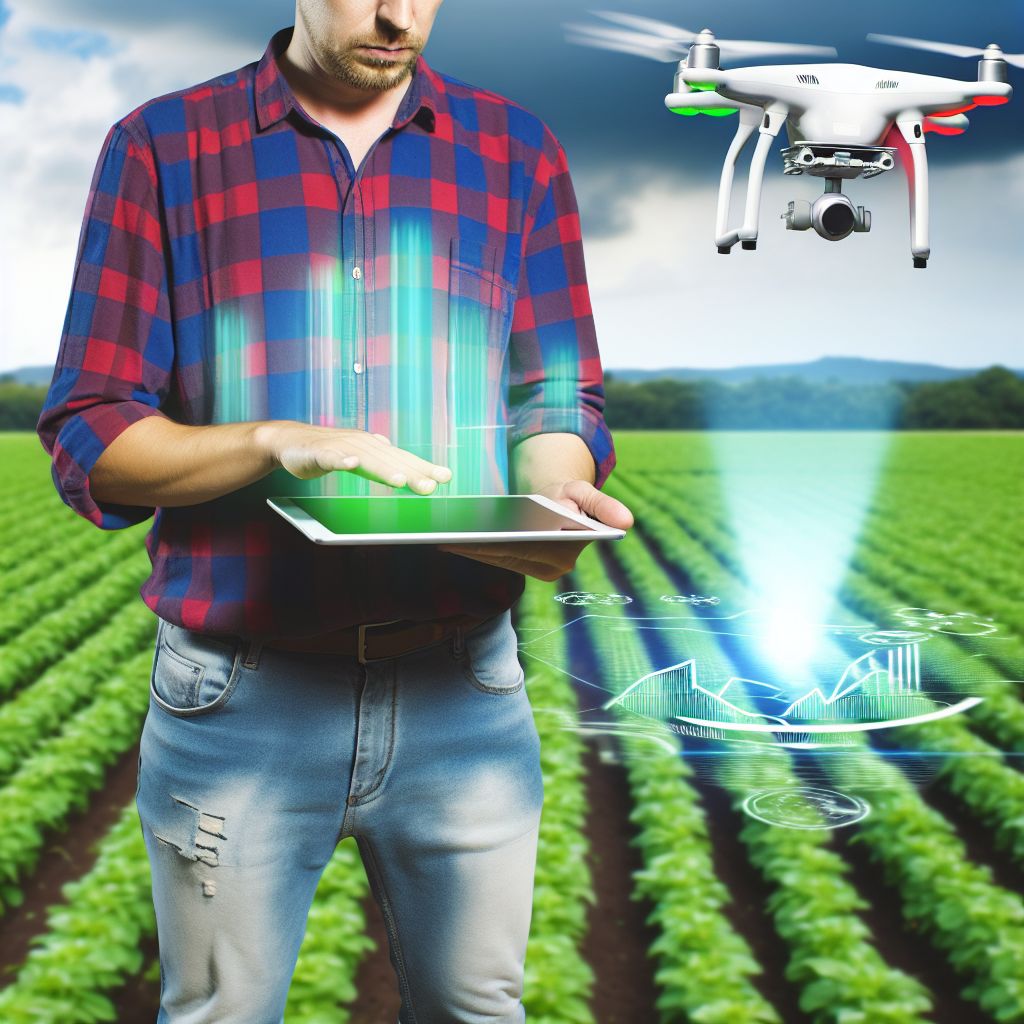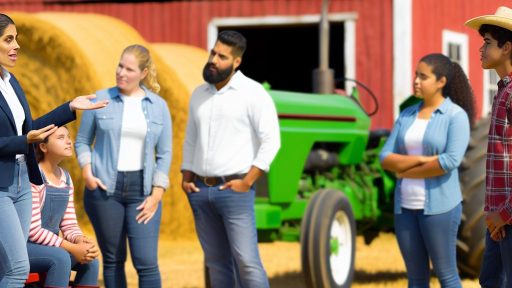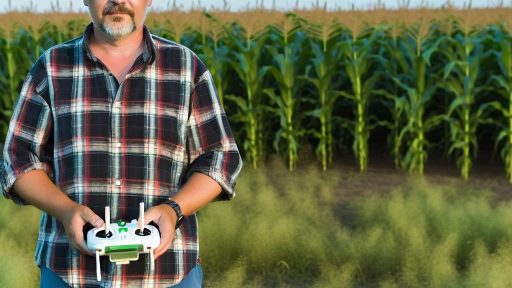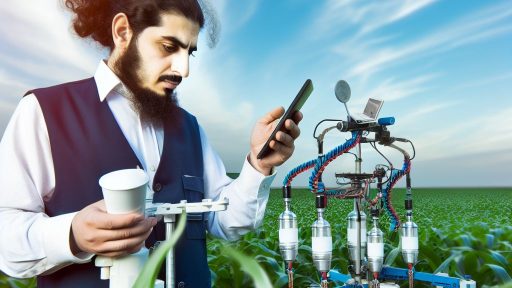Introduction to Drones in Agriculture
Overview of Drone Technology
Drones have transformed many industries, particularly agriculture.
These flying devices collect data rapidly and efficiently.
Farmers now utilize drones to monitor crops from above.
This aerial perspective provides invaluable insights.
Consequently, farmers can make informed decisions based on real-time data.
Importance of Drones in Farming
Utilizing drone technology enhances agricultural productivity.
Drones increase efficiency in data collection and analysis.
Farmers can track plant health and soil conditions easily.
As a result, they can identify issues before they escalate.
This proactive approach leads to better crop yields.
Applications of Drones in Agriculture
Drones serve multiple applications in farming operations.
- They assist in crop mapping, providing detailed field layouts.
- Drones help in monitoring irrigation systems effectively.
- They aid in pest and disease detection early on.
- Farmers use drones to assess crop damage post-storms.
- Additionally, drones facilitate precision spraying of pesticides.
Future of Drone Technology in Agriculture
The future of drone integration in agriculture appears promising.
Advancements in technology will enhance their capabilities.
We can expect drones to become more autonomous over time.
Moreover, machine learning algorithms will improve data analysis.
Transform Your Agribusiness
Unlock your farm's potential with expert advice tailored to your needs. Get actionable steps that drive real results.
Get StartedThis evolution will enable even smarter farming decisions.
Types of Drone Technologies Used in Farming
Introduction to Drone Technologies
Drones are revolutionizing the agricultural landscape.
They provide innovative solutions for farmers.
Farmers now depend on these technologies for efficiency.
Multispectral Drones
Multispectral drones capture data across multiple wavelengths.
This technology helps in monitoring crop health.
Farmers can detect problems such as pests or disease early.
Additionally, it assists in analyzing plant vigor.
Such insights allow for precise interventions.
LiDAR Drones
LiDAR drones utilize laser light to measure distances.
They create high-resolution topographical maps.
This method aids in assessing field elevation and terrain.
Farmers use LiDAR for better irrigation management.
By mapping water flow, they optimize resource use.
Thermal Drones
Thermal drones monitor temperature variations in fields.
Such data helps in understanding irrigation needs.
Farmers can identify areas requiring more water efficiently.
Moreover, they assist in detecting livestock health issues.
This technology enhances decision-making processes.
Fixed-Wing Drones
Fixed-wing drones cover larger farm areas effectively.
They provide comprehensive aerial surveys quickly.
This makes them ideal for extensive farming operations.
Furthermore, they are efficient in fuel usage.
Farmers benefit from their extended flight times.
Showcase Your Farming Business
Publish your professional farming services profile on our blog for a one-time fee of $200 and reach a dedicated audience of farmers and agribusiness owners.
Publish Your ProfileQuadcopters
Quadcopters are versatile in various farming tasks.
They can capture high-resolution imagery easily.
This technology is helpful for real-time monitoring.
Farmers use quadcopters for field inspections routinely.
Additionally, they are valuable for livestock management.
Benefits of Drone Technologies in Agriculture
Drone technology offers numerous benefits to farmers.
Each type serves a unique purpose to enhance farming practices.
As technology evolves, farming will continually improve.
Ultimately, this will lead to more sustainable agricultural outcomes.
Collecting Data with Drones: Best Practices for Farmers
Understanding the Role of Drones in Agriculture
Drones play a vital role in modern agriculture.
They enable farmers to collect data efficiently.
Moreover, they offer high-resolution imagery of crops.
This technology enhances decision-making processes.
Selecting the Right Drone
Choosing the appropriate drone is crucial.
Consider the size and layout of your farm.
For instance, smaller farms might benefit from compact drones.
Conversely, larger farms may require more robust models.
Evaluate the payload capacity to ensure it meets your needs.
Understanding Regulatory Guidelines
Farmers must familiarize themselves with local regulations.
Each region has specific laws governing drone usage.
Consult with aviation authorities before operating drones.
Compliance with regulations helps avoid fines and legal issues.
Ensuring Proper Training
Training is essential for effective drone operation.
Farmers should seek certified training programs.
These programs enhance flying skills and data collection techniques.
Moreover, knowledgeable operators reduce the risk of accidents.
Data Collection Techniques
Effective data collection involves planning and strategy.
First, define your objectives clearly.
Next, determine the best times for flying.
Weather conditions significantly impact data quality.
Please fly during clear weather for optimal results.
Analyzing the Collected Data
After collecting data, analysis becomes vital.
Use software tools to process and interpret the information.
Look for patterns that indicate crop health and performance.
This analysis helps in making informed decisions.
Integrating Drone Data with Farm Management
Integrate drone data with existing management systems.
This creates a comprehensive overview of farm operations.
Farmers can enhance crop monitoring and resource management.
Additionally, improved insights lead to better yields.
Staying Updated on Technology
Technology in drone usage is constantly evolving.
Showcase Your Farming Business
Publish your professional farming services profile on our blog for a one-time fee of $200 and reach a dedicated audience of farmers and agribusiness owners.
Publish Your ProfileFarmers should stay informed about advancements.
Participating in workshops and online forums is helpful.
Networking with other farmers can provide valuable insights.
Explore Further: Biodegradable Packaging Solutions Supporting Sustainable Agriculture
Analyzing Drone Data: Tools and Techniques for Interpretation
Understanding the Importance of Drone Data
Drone data provides valuable insights for modern agriculture.
Farmers can monitor crop health and assess soil conditions.
This technology enhances decision-making capabilities significantly.
Data Collection Techniques
Drones utilize various sensors to gather data.
Common sensors include RGB cameras, multispectral cameras, and LiDAR.
Each sensor type serves distinct purposes in agricultural analysis.
RGB Cameras
RGB cameras capture high-resolution images of fields.
Farmers use these images to identify problem areas swiftly.
Such analysis can reveal crop diseases or pest infestations easily.
Multispectral Cameras
Multispectral cameras offer insights into plant health.
They measure light reflected at different wavelengths.
Farmers can assess the NDVI (Normalized Difference Vegetation Index) accurately.
LiDAR Technology
LiDAR provides precise elevation data of farmland.
It helps in understanding topography and drainage patterns.
This information is crucial for effective irrigation planning.
Data Processing Tools
Processing drone data requires specialized software.
Popular tools include Pix4D, Agisoft Metashape, and DroneDeploy.
These platforms facilitate image stitching and 3D modeling.
Pix4D
Pix4D offers robust tools for agricultural mapping.
Its cloud processing capabilities enhance data accessibility.
Farmers can generate detailed orthomosaic maps for analysis.
Agisoft Metashape
Agisoft Metashape excels in creating 3D models.
It provides accurate surface mapping and volumetric calculations.
This tool aids in monitoring changes in crop yield over time.
DroneDeploy
DroneDeploy simplifies the drone data analysis process.
It features user-friendly interfaces for easy navigation.
Farmers can create actionable insights with minimal training.
Interpreting the Data
Data interpretation is critical for practical implementation.
Farmers should focus on specific metrics to derive insights.
Key metrics include crop vigor, moisture levels, and stress indicators.
Yield Prediction
Yield prediction models utilize captured data effectively.
Farmers can make informed planting and harvesting decisions.
This approach maximizes productivity and minimizes losses.
Pest and Disease Monitoring
Drone data assists in early pest and disease detection.
Swift interventions can prevent widespread crop damage.
Ultimately, this enhances overall crop management strategies.
Showcase Your Farming Business
Publish your professional farming services profile on our blog for a one-time fee of $200 and reach a dedicated audience of farmers and agribusiness owners.
Publish Your ProfileImplications for Agricultural Practices
Utilizing drone data optimizes farming practices significantly.
Farmers can achieve improved efficiency and sustainability.
With the right tools and interpretation techniques, agriculture thrives.
Delve into the Subject: Renewable Energy Technologies for Livestock Farming
Case Studies: Successful Implementation of Drones in Farming
Overview of Agricultural Drone Use
Agricultural drones provide a new perspective on farming operations.
Farmers use drones to capture detailed aerial images of their fields.
These images aid in monitoring crop health and pest issues.
Additionally, drones streamline irrigation management and soil assessment.
Case Study 1: Precision Agriculture in the Midwest
Green Fields Farm, located in Nebraska, adopted drone technology last year.
The farm successfully implemented drones for crop monitoring.
Utilizing multispectral imaging, the farmers identified nutrient deficiencies.
This helped optimize their fertilizer applications.
As a result, they increased their yield by 15% this season.
Case Study 2: Vineyard Management in California
Harvest Moon Vineyards in Sonoma County utilizes drones for vineyard assessment.
The vineyard owners deploy drones to collect data on grape health.
They analyze this information to make informed irrigation decisions.
This approach has reduced water usage by 30%.
Moreover, it has improved overall grape quality.
Case Study 3: Crop Surveillance in Australia
Outback Farms in Queensland adopted drones for crop surveillance.
They monitor extensive areas quickly and efficiently.
Drones equipped with thermal sensors detect water stress in crops.
Consequently, the farmers can target irrigation more accurately.
This practice minimizes water waste and improves crop health.
Technological Advancements in Drone Usage
Recent technological advancements enhance drone capabilities for farmers.
New software allows for real-time data analysis directly from the field.
Farmers can implement changes immediately based on the received data.
This leads to faster decision-making and improved productivity.
Future Trends in Agricultural Drone Technology
The future of agricultural drones looks promising.
Innovations will likely focus on improved battery life and payload capacities.
Additionally, machine learning will play a significant role.
This will allow drones to analyze crop patterns and predict issues.
Farmers can anticipate challenges and adapt proactively.
Learn More: Streamlining Farm Finances With Advanced Agri-Fintech Solutions

Integrating Drone Data with Other Agricultural Technologies
The Role of Precision Agriculture
Precision agriculture enhances farming efficiency through data-driven decision-making.
This approach employs various technologies to maximize crop yields.
Drone data offers valuable insights into soil health and crop conditions.
Farmers can combine this data with satellite imagery for comprehensive analysis.
Combining Drone Data with IoT Devices
Integrating drones with Internet of Things (IoT) devices increases data accuracy.
IoT sensors collect real-time data on soil moisture, temperature, and nutrient levels.
When coordinated with drone data, farmers gain a holistic view of their fields.
Showcase Your Farming Business
Publish your professional farming services profile on our blog for a one-time fee of $200 and reach a dedicated audience of farmers and agribusiness owners.
Publish Your ProfileThis synergy informs irrigation decisions and fertilization strategies.
Utilizing Data Management Software
Data management software helps farmers analyze drone data effectively.
These platforms support data visualization and historical comparisons.
Farmers can identify trends and patterns for informed decision-making.
Moreover, software solutions enable integration with other farming technologies.
Enhancing Decision-Making with Analytics
Data analytics tools are essential for interpreting drone-collected information.
These tools can forecast crop yields based on current conditions.
Farmers can adjust practices to optimize resource allocation and production.
Access to predictive analytics allows for proactive management of crops.
Collaboration with Agricultural Experts
Collaborating with agronomists enhances the benefits of drone technology.
Experts can provide tailored advice based on analysis of drone data.
Utilizing their experience helps farmers implement best practices.
This partnership fosters a better understanding of the land’s unique needs.
Exploring Future Possibilities
The integration of drone data with agricultural technologies is evolving rapidly.
Emerging technologies promise even greater efficiencies for farmers.
As drones become more sophisticated, they will gather more precise data.
Future advancements lie in automating data integration for streamlined operations.
See Related Content: Drones In Agriculture: Improving Harvest Accuracy
Regulatory Considerations for Drone Use in Agriculture
Overview of Regulations
Drones in agriculture must comply with regulations set by various authorities.
In the United States, the Federal Aviation Administration (FAA) oversees drone operations.
Farmers must adhere to Part 107 rules for commercial drone use.
These rules include restrictions on flying altitude and airspace operations.
Obtaining Proper Licenses
To operate drones legally, farmers need a Remote Pilot Certificate.
This certification confirms the operator’s understanding of airspace rules.
Additionally, operators must pass a knowledge test administered by the FAA.
Regular recertification ensures that pilots remain informed about updates.
Privacy Concerns
Drone operators must address privacy issues regarding data collection.
Farmers should inform nearby residents about drone operations.
Respecting privacy laws is vital when capturing images or video.
It’s advisable to develop protocols to safeguard personal information.
Insurance Requirements
Insurance is essential for protecting against potential liabilities.
Farmers should consider liability coverage for drone operations.
This coverage mitigates financial risks associated with accidents.
Consulting with insurance providers can help determine appropriate policies.
Future Trends in Regulations
As drone technology evolves, regulations will continue to change.
Farmers should stay informed about proposed regulatory updates.
Active participation in agricultural associations can offer insights.
Collaborating with industry groups also helps influence regulations.
Future Trends: The Evolution of Drone Technology in Smart Farming
Advancements in Drone Design
Drone technology is rapidly evolving to meet agricultural needs.
Manufacturers are developing drones with improved flight time and payload capacity.
Showcase Your Farming Business
Publish your professional farming services profile on our blog for a one-time fee of $200 and reach a dedicated audience of farmers and agribusiness owners.
Publish Your ProfileAdditionally, new materials enhance durability and reduce maintenance costs.
These advancements allow farmers to monitor larger areas efficiently.
Integration with AI and Machine Learning
Integrating artificial intelligence with drones revolutionizes data analysis.
Farmers can access real-time insights for better decision-making.
This combination helps to identify crop health issues quickly.
Moreover, machine learning algorithms predict crop yields accurately.
Improved Data Collection Techniques
Drones now offer high-resolution imaging for detailed assessments.
This technology aids in identifying pests and diseases early.
Moreover, multispectral and thermal imaging provide crucial data on soil moisture.
Farmers can utilize this information to optimize irrigation practices.
Regulatory Developments
As drone usage increases, regulations evolve to ensure safety.
Governments establish guidelines for agricultural drone operations.
These regulations focus on airspace management and privacy concerns.
Compliance with these laws is essential for successful drone deployment.
Adoption Trends Among Farmers
More farmers are adopting drone technology as its benefits become evident.
Initial costs are decreasing as technology becomes more accessible.
Furthermore, many farmers are sharing success stories to inspire others.
This trend encourages a collaborative approach to smart farming.
Future Innovations on the Horizon
Researchers are exploring the use of drones for precision planting.
This technology could change the way farmers sow seeds.
Future drones may operate autonomously using advanced navigation systems.
Moreover, they could integrate seamlessly with IoT devices on the farm.
Additional Resources
IoT in Agriculture: 9 Technology Use Cases for Smart Farming (and …
The Path to Smart Farming: Innovations and Opportunities in …




